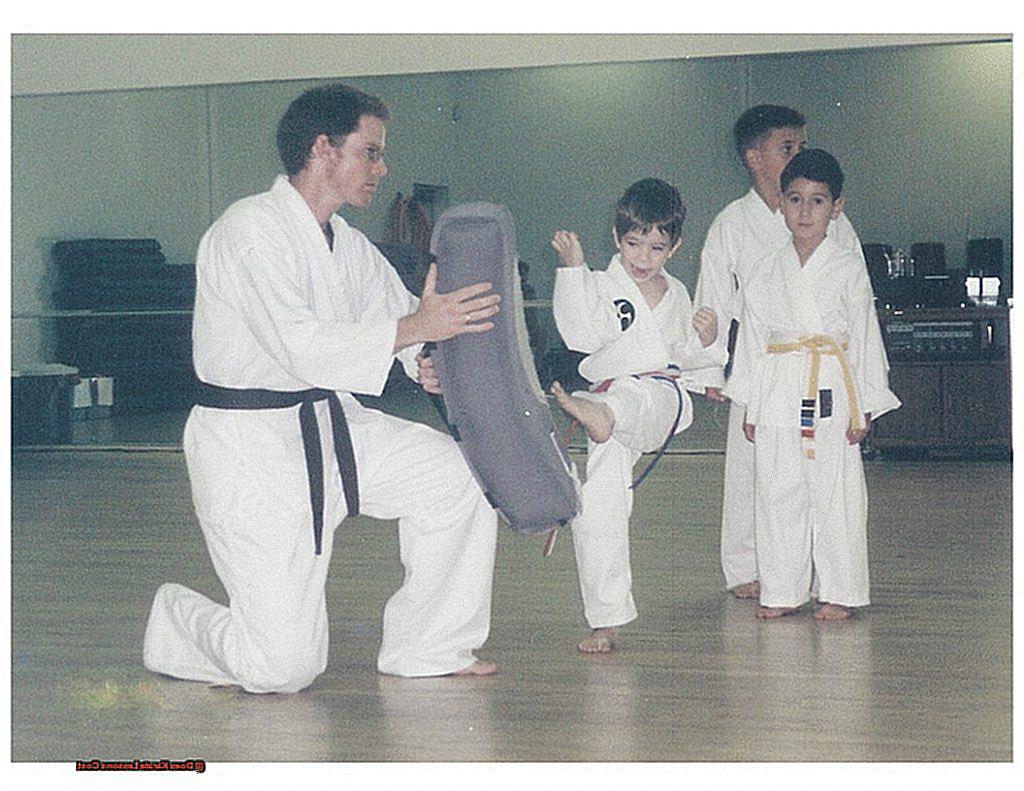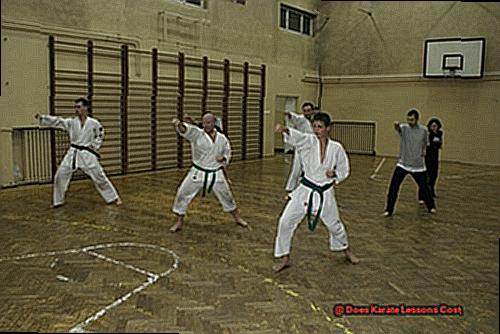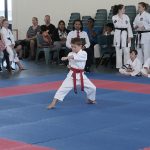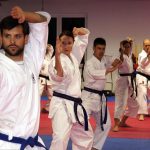Are you ready to embark on a journey of self-discovery and physical strength through the art of karate? As enticing as it may sound, before you dive into the world of martial arts, it’s crucial to consider the cost of lessons. In this blog post, we will delve into the average cost of karate lessons and explore various factors that may impact the price. So, let’s get started and uncover everything you need to know.
First things first, let’s talk about location. The cost of karate lessons can vary depending on where you live. For example, classes in big cities may be more expensive than in smaller towns due to higher living costs. Next up is instructor experience – a highly experienced teacher may charge more for their expertise compared to a beginner instructor.
Now, let’s get down to numbers. On average, group lessons can range from $50-$150 per month, while private lessons can cost anywhere between $75-$200 per hour. But wait, there’s more. Additional expenses such as uniform fees, equipment costs, and testing fees should also be factored in when considering the overall cost.
But don’t let these numbers discourage you. Some schools offer discounts for multiple family members or prepaid packages which can help lower the expenses. It’s essential to do your research and compare different schools and instructors to find one that fits your budget and goals.
So there you have it – a breakdown of the cost of karate lessons. Join us as we explore this topic further and help you make an informed decision about starting your martial arts journey. Let’s kickstart this adventure together.
Average Price for Karate Lessons
The cost for intermediate or advanced karate lessons typically ranges from $100 to $200 per month. However, various factors can influence this price, such as location, class type, and instructor experience.
| Average Cost | |
|---|---|
| Location | $50 to $150 per month |
| Class Type | $0 to $80 per hour for private lessons $50 to $150 per month for group classes |
| Instructor Experience | Varies depending on rank and reputation |
The location of the karate class is a crucial factor that can significantly impact the cost. Urban areas, where space is limited and demand is higher, often have more expensive classes compared to rural areas. Private lessons also tend to be pricier than group classes, and specialized classes may have their own unique pricing structures.
Additionally, the experience and reputation of the instructor can also impact the cost, with more experienced or renowned instructors charging higher fees.
It is essential to carefully consider these factors when selecting a karate class as the cost is an investment in both physical and mental well-being. With dedication and consistent practice, students can see significant improvements in their confidence, discipline, and overall fitness.
While the average cost for karate lessons may seem steep initially, the long-term benefits make it a worthwhile investment.
Online Karate Programs
Online karate programs can range in price from $30 to $100 per month, depending on the platform and instructor. This is significantly less expensive than in-person lessons, which can cost anywhere from $100 to $200 per month. However, the cost of online programs may vary based on the level of instruction and additional resources offered.
One of the benefits of online karate programs is the flexibility they provide in terms of scheduling and pace of learning. Students have the freedom to access classes at any time and work at their own speed, making it an ideal option for those with busy schedules or who prefer self-directed learning.
While online training may not offer the same social aspect or physical contact as in-person lessons, it still allows for the development of core values such as coordination, flexibility, focus, and respect. Additionally, with many top-level instructors now offering online classes due to the COVID-19 pandemic, students have access to high-quality training from the comfort of their own home.
It’s worth noting that traditional weapon training may not be as readily available in online programs compared to a physical dojo. However, some online programs do offer virtual weapon training or provide resources for students to practice with at home.
While online karate programs may not replicate the same experience as in-person lessons, they offer a more affordable option with flexibility and access to top-notch instructors.
Do you need to buy a karate uniform?
While it may not be a requirement, it is highly recommended for its symbolic meaning, practical advantages, and reasonable price.
When starting your journey as a karate student, purchasing a gi (uniform) is an important step to take. Not only does it symbolize your dedication and commitment to the art, but it also serves practical purposes during training. And the best part? It won’t break the bank.

As a karate practitioner myself, I have experienced the significance of owning a proper gi firsthand. When I first began my training, I showed up in regular workout clothes, thinking it wouldn’t make a difference. However, my sensei (teacher) emphasized the importance of having a gi and convinced me to get one. And let me tell you, it made all the difference.
Firstly, wearing a gi represents respect for the art and its traditions. It shows that you take your training seriously and are willing to invest in yourself. Additionally, the white color of the gi symbolizes purity and an open mind to learning. As Bruce Lee once said, “Empty your mind, be formless, shapeless – like water.” This is why many dojos (training halls) require students to wear a clean, white gi during class.
Secondly, a gi has practical benefits during training. The lightweight and loose-fitting material allows for maximum mobility and comfort while performing techniques. On the other hand, judo gis are tighter and heavier due to reinforced stitching to withstand grabs and throws. This can hinder movement and make training more difficult for beginners.
Lastly, purchasing a gi is affordable compared to other martial arts uniforms. You can find quality gis for as low as $20-30 dollars online or at your local martial arts store. This is a small investment for the long-term benefits it provides.
So, while buying a karate uniform may not be mandatory, it is highly recommended for its symbolic significance, practical benefits, and reasonable cost. It is a small but important step in your journey as a karate student, and I highly encourage you to make the investment.
Do you need to pay for belt Testing (Gradings)?
The answer is yes. Typically, the cost of testing varies depending on the school and the level being tested for. However, it is an essential expense for students to progress in their training and achieve higher ranks.
In most traditional schools, students must pass a series of tests to advance to the next belt level. Each test brings them closer to achieving a black belt. These tests typically require payment to cover the costs of materials, space rental, and instructor fees.
The specific skills required for each belt level are outlined in the Student Progress Manual, which is given on the first day of class. Instructors or Hanshi Madani will determine when a student is ready to test for their next belt and provide them with an application. This process ensures that students are adequately prepared and have mastered the necessary skills before advancing.
There are eight color belt tests and two black belt tests available per year, with dates announced at least two months in advance. This allows students to plan and budget for their testing expenses ahead of time.
In addition to paying for the actual test, students must also earn a certain number of stripes on their belts before being eligible to test for the next level. These stripes are usually earned through consistent attendance, effort, and improvement in class.
After testing, students receive a confidential written evaluation from their instructor with personalized feedback and suggestions for improvement. This valuable feedback helps students continue to grow and progress in their training.
Upon passing a test, students are awarded a new belt and certification of their rank at the next class. This serves as a tangible representation of their hard work and dedication.
Throughout the year, students can also earn colored stripes on their belts as a way to track progress and celebrate achievements. These stripes can serve as motivation and encouragement for students to continue improving and working towards their goals.
Do I need to buy a karate Belt?
Yes, it is essential to purchase a karate belt in order to participate in karate lessons. The karate belt, also known as an “obi”, is a crucial component of the karate uniform and serves as a symbol of one’s progress and level in training. It is a representation of dedication and hard work, serving as a reminder to continue striving for improvement.
| Reasons for purchasing a karate belt: | Explanation: | Source: |
| Karate belt signifies progress and level in training | The color of the karate belt represents the rank and progress of a student in their training. | https://www.karatesupply.com/pages/karate-belt-ranks |
| Karate belt is an essential part of the uniform | The karate uniform (gi) consists of a jacket, pants, and belt. The belt is necessary to complete the uniform and participate in lessons. | https://www.ikakarate.com/the-uniform/ |
| Karate belt serves as a symbol of dedication and hard work | The process of earning higher ranks through testing requires consistent effort and improvement, making the karate belt a representation of one’s dedication and hard work. | https://www.wikihow.com/Tie-a-Karate-Belt |
| Karate belt provides motivation to continue striving for improvement | As students progress through different belt levels, the karate belt serves as a reminder to continue working towards improvement and higher ranks. | https://www.theodysseyonline.com/karate-belts-meaning-behind-color |
Apart from the reasons mentioned above, purchasing a karate belt also offers practical benefits for participating in karate lessons. The belt helps to secure the gi jacket during training and provides support for the lower back during intense movements. It also serves as a helpful tool for instructors to grab onto during certain techniques.
While some may argue that purchasing a karate belt is not necessary as one can simply borrow or rent a belt, it is important to have one’s own belt for personal hygiene and to avoid any potential discomfort or distractions during training.
Moreover, investing in a karate belt is a small expense compared to the overall cost of karate training. As noted in the research, the average cost of karate lessons can range from $91 per month to $22 per week. In comparison, the cost of a karate belt ranges from $20 to $150 depending on the quality and brand.
Do I need to buy Karate Equipment?
When considering joining karate lessons, it’s important to have the right equipment. This includes a gi uniform, belt, protective gear, hand pads and mitts, punching bag, martial arts mats, and weapons for advanced practitioners. The cost of these items can range from $100 to $500 on average, depending on the quality and type of gear purchased. However, investing in high-quality equipment is crucial for safety and effectiveness during training.
As a seasoned karate practitioner, I’ve learned the hard way that using the wrong equipment can lead to serious injuries and hinder progress. When I first started training, I made the mistake of purchasing a cheap gi uniform that tore easily and didn’t provide enough protection. As a result, I had to frequently replace it and suffered injuries due to inadequate padding.
On the other hand, my friend invested in a high-quality gi uniform with reinforced stitching and durable fabric. Not only did it last longer, but it also provided better protection during sparring sessions. He was able to focus on his technique without worrying about his gear falling apart.
Similarly, investing in quality protective gear is crucial for avoiding injuries during training. Hand pads and mitts with proper padding can prevent hand injuries while punching bags with sturdy construction can prevent joint injuries. It may be tempting to save money by purchasing cheaper equipment, but it’s not worth risking your safety.
Any other hidden fees when starting karate?
When starting karate lessons, it’s important to understand that there may be a few added costs and fees to consider. These can include the cost of lessons themselves, purchasing a karate uniform or gi, grading tests, and potentially other equipment or insurance. But don’t let these expenses deter you from investing in quality instruction and equipment for the best training experience. Let’s take a closer look at these costs and what they entail.
The cost of lessons can vary depending on the type of class and instructor. On average, students can expect to pay around $91 per month or $22 per week for group classes. Private one-hour sessions may cost between $50 and $80, but offer personalized attention and faster skill development.
Aside from lesson costs, students will also need to invest in a karate uniform or gi. These can range from $20 to $150 depending on the level of experience. It is recommended to purchase one once you fully commit to the sport. Grading tests for each belt level may also come with added fees, typically ranging from $40 to $150, with the price increasing as you progress. The color of your belt represents your level of training.
For those interested in kumite (fighting), additional equipment such as gloves and protective gear may be necessary after reaching a certain level, which can cost around $70. More advanced training equipment may also be required at some point, so it’s crucial to have a good relationship with your instructor for guidance in making these decisions.
Furthermore, some in-person dojos may require students to have insurance, which can add an extra expense. However, it’s important to remember that the quality of service and personal motivation are key factors in getting the most out of your karate training, not just the price. Researching different schools and trying out a trial session can help determine if it’s the right fit for you.
Conclusion
In conclusion, the initial cost of karate lessons may seem daunting, but the long-term benefits are well worth it.
From physical strength and self-discovery to discipline and confidence, this martial art offers a multitude of advantages for those who embark on the journey. However, before taking the plunge, it’s important to understand the average cost of lessons and potential factors that may affect it.
These include location, instructor experience, and additional expenses like uniforms and equipment. While these numbers may vary depending on various factors, thorough research and comparison of different schools and instructors can help find a suitable option within your budget.
It’s also important to keep in mind other possible costs such as belt testing fees or purchasing equipment for safety and progress in training. Ultimately, when it comes to starting your karate journey, the benefits far outweigh the cost.






